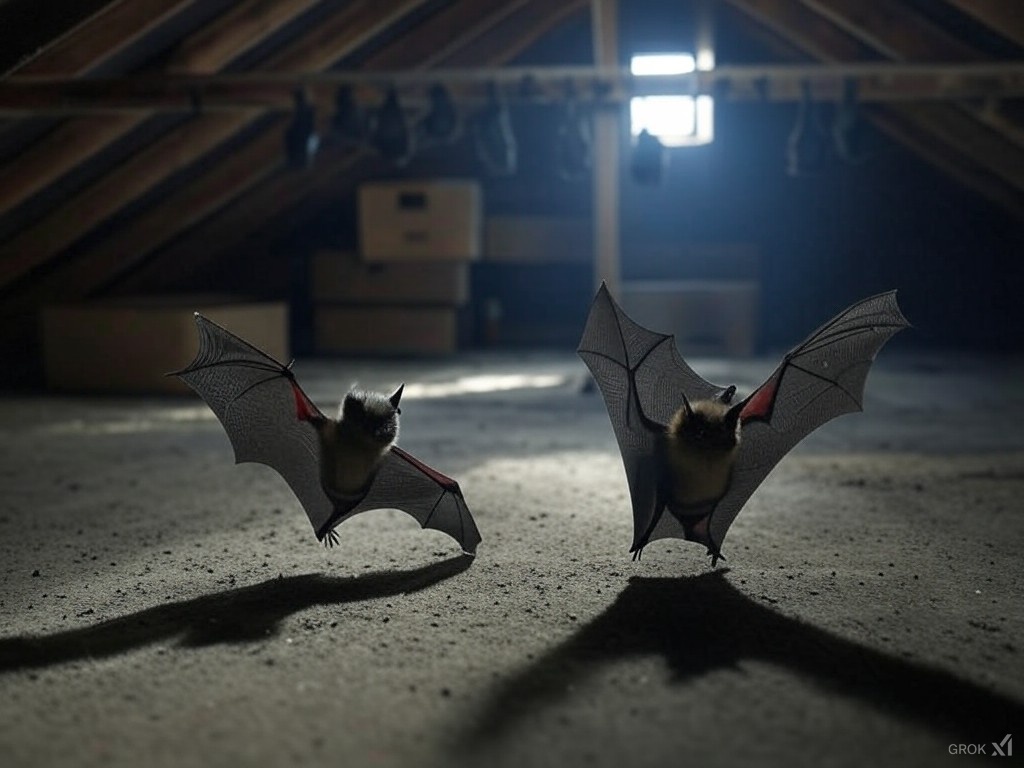Bats in an attic can cause multiple types of damage, both directly and indirectly. Bat removal is done using one-way exclusions so they leave and can’t get back in. Once bats are out repairs can be done and the attic inspected for debris. Bat removal cannot be done during the maternity period from May 15-July 15.

Here’s a detailed look at the potential issues:
Structural and Material Damage:
- Guano (Bat Droppings) Accumulation:
- Weight: Over time, the accumulation of guano can become heavy, potentially compromising the structural integrity of ceilings or floor joists.
- Corrosion: Guano is acidic, and when it accumulates in large amounts, it can corrode wood, metal, and other materials, leading to structural weakening.
- Urine Stains and Odor:
- Staining: Bat urine can stain surfaces, particularly insulation and wood, altering their appearance and potentially causing discoloration on ceilings below the attic.
- Odor: The smell from urine and guano can be overwhelming and pervasive, making living spaces below the attic unpleasant.
- Nesting Materials:
- Bats might use insulation to create nests, reducing its effectiveness and leading to energy loss in the home.
Health and Hygiene Issues:
- Disease Transmission:
- Histoplasmosis: This fungal infection can develop from inhaling spores in bat guano. It’s particularly dangerous if the droppings are disturbed, releasing spores into the air.
- Rabies: Although less common, bats can be carriers of rabies, and their presence increases the risk, particularly if there’s direct contact.
- Parasites:
- Bats can harbor fleas, ticks, and bat bugs (similar to bed bugs), which might infest the attic and potentially move into living areas.
Additional Concerns:
- Noise: Bats can be quite noisy, especially when entering or exiting the attic or when active at night, which can disturb people living below.
- Insulation Damage: Beyond using it for nesting, the urine and guano can ruin insulation, reducing its R-value and effectiveness, leading to higher energy costs.
- Property Value: The presence of bats and the associated damage can significantly decrease property value or complicate the sale of a home.
Mitigation:
- Exclusion: The most effective method is to use exclusion devices that allow bats to leave but not return. This should be timed when pups are not present (typically late summer or early autumn) to avoid trapping young inside.
- Clean-Up: After ensuring no bats remain, thorough cleaning is necessary, including the removal of guano and contaminated insulation, followed by sanitizing the area. This often requires professional services due to health risks.
- Preventive Measures: Seal all possible entry points after exclusion, ensuring they are bat-proof but still allow for ventilation to prevent moisture buildup.
- Professional Help: Given the health risks and complexity of bat removal, especially in large colonies, it’s often wise to consult with professionals who can handle the situation legally, safely, and humanely.
- Legal Considerations: In many regions, bats are protected, so it’s crucial to follow local wildlife laws concerning bat removal and habitat conservation.
While bats play an important role in ecosystems, particularly in insect control, their presence in an attic can lead to significant health and structural issues that necessitate careful management.
